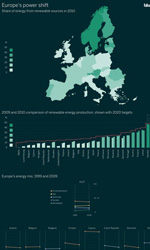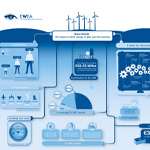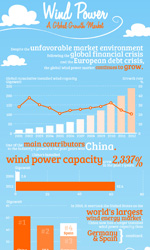A picture tells a thousand words. An infographic even more.
 With some design flair and imagination, the significance of information lost in the deluge of facts and figures can be made clear. The current spate of infographics floating around the web has brought to light several important facts that had been buried in thick reports, until rescued by a graphic designer.
With some design flair and imagination, the significance of information lost in the deluge of facts and figures can be made clear. The current spate of infographics floating around the web has brought to light several important facts that had been buried in thick reports, until rescued by a graphic designer.
A current favourite on the various EWEA social media platforms (Facebook, Google+, Twitter, LinkedIn AND Pinterest!) is an attractively designed infographic entitled ‘Europe’s Power Shift’. In muted tones of green, it tells a story that we should all be reminded of and aware of – that Europe, and in particular Scandinavia, is incorporating remarkable amounts of renewable energy into its power mix, with major changes occurring over the last ten years.
In the infographic, Sweden emerges as a shining beacon in the north, with 2010 figures showing that 46.9% of its energy came from renewable sources – albeit with heavy use of hydropower. The runner up is Latvia, with 34.3%, followed by Finland, with 33.6%. All are definitely on target to reach their 2020 objectives, which are prominently displayed in red on the graphic. The infographic also includes a fascinating visual breakdown of each country’s fuel mix change between 1999 and 2009.
Another striking feature of the graphic is the map of Europe, which belies the impression many people would have of countries like Ireland, the UK, Belgium and Holland as significant renewable energy users. If speaking per captia, Ireland may indeed have high use of wind energy, but in overall European terms it is still in the bottom rung for use of renewable energy.
 Earlier on this year EWEA produced an infographic in connection with the report entitled Green Growth – the impact of wind energy on jobs and the economy. The infographic focused on the benefits to the EU of wind energy, such as the €32.43 billion contributed in tax (0.26% of total EU GDP in 2010, an increase of 33% since 2007), and the 238,155 jobs (growing to 794,079 by 2030) and the fact that the wind energy sector is one of the largest economic sectors in the EU, larger than clothing, furniture or civil aircraft manufacture.
Earlier on this year EWEA produced an infographic in connection with the report entitled Green Growth – the impact of wind energy on jobs and the economy. The infographic focused on the benefits to the EU of wind energy, such as the €32.43 billion contributed in tax (0.26% of total EU GDP in 2010, an increase of 33% since 2007), and the 238,155 jobs (growing to 794,079 by 2030) and the fact that the wind energy sector is one of the largest economic sectors in the EU, larger than clothing, furniture or civil aircraft manufacture.
A more specific and current infographic is Wind Power – A global growth market. Anyone who follows the wind power industry closely will not be too surprised by the information presented, but it is good to see it visually, with a colourful, attractive layout, rather than in black and white tables.
The info presented makes it clear that; “despite the unfavourable market environment following the global financial crisis and the European debt crisis, the global wind power market continues to grow”; wind power capacity growth over the past five years has been 2,337%; and China now has a larger installed wind power capacity than Germany and Spain combined.
Other interesting infographics that we have come upon include one on Understanding Carbon Offsets, another explaining How Wind Energy is Harvested and our very own attempt here at EWEA, showing the Top Ten Largest Onshore Windfarms in Europe.







